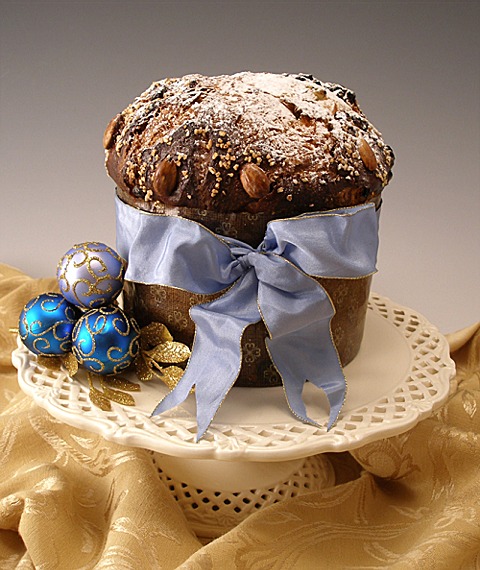
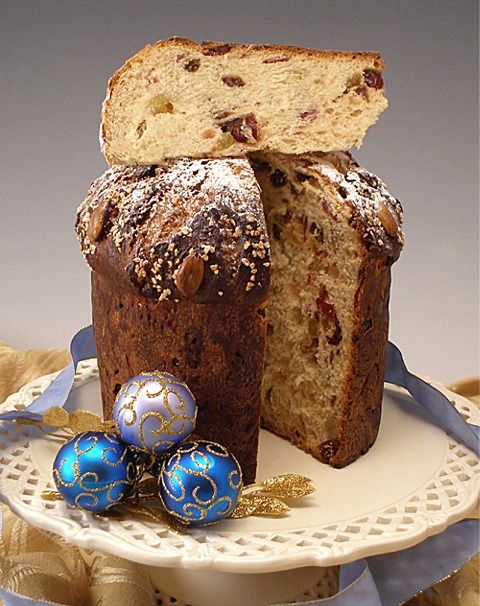
Panettone is a rich and delicious Italian Christmas yeasted sweet bread, studded with raisins and jewel-toned glacéed citron. We have replaced it with dried cranberries and golden raisins, but you can use any dried fruit you desire. It tastes good as is sliced and spread with butter or toasted beforehand. Or, eat a slice of fresh panettone with a glass of sweet wine, such as Vin Santo. It can also be used in a variety of desserts, such as replacing the cake with it in a trifle or using as the bread in a Bread Pudding recipe. Sliced Panettone makes excellent French toast, too.
BREAD RECIPE HELP
INGREDIENTS
Dried fruit mixture:
2/3 cup raisins
2/3 cup golden raisins
2/3 cup dried cranberries
3 tablespoons (1 jigger) rum
3 tablespoons (1 jigger) brandy
3 tablespoons water
Panettone dough:
4 cups unbleached all-purpose flour; use Gold Medal All-purpose Flour or other. Do not use King Arthur
2/3 cup sugar
1/2 teaspoon salt
1/2 teaspoon active dry yeast – best kind SAF Gold Yeast (especially made for sweet doughs)
Zest of 1 lemon
Zest of one orange
3 large eggs
2/3 cup lukewarm water; about 100 – 110 degrees F
1 tablespoon honey
2 teaspoons vanilla extract; for authentic panettone, omit vanilla and add 1 teaspoon Fiori di Sicilia
10 tablespoons unsalted butter, softened
Finishing Touches:
beaten egg wash: 1 large egg beaten with 1/2 teaspoon water
2 tablespoons Pearl sugar, or more if needed
6 blanched almonds, optional
1 tablespoon chilled unsalted butter
Powdered sugar, sifted
Special equipment:
HEAVY DUTY stand mixer
Paper Panettone Mold*; purchase one 6- x 4.5-inch cylindrical paper panettone mold
Two 15-inch or longer metal skewers, if using paper mold. Do not use wood.
*NOTES
Or, use two 2 (10- to 15-oz) clean coffee cans (paper or plastic labels removed)
INSTRUCTIONS
STEP I: MAKE THE PANETTONE DOUGH
Prepare the dried fruit mixture:
1. Soak the dried fruit using our “fast soak method”:
Place the raisins, golden raisins, and cranberries in a plastic resealable plastic bag. Add the rum, brandy, and water, and squeeze as much air as
possible out of the bag before closing. (This maximizes the surface area contact between the fruit and the liquor, and makes sure no fruit
is left dry.)
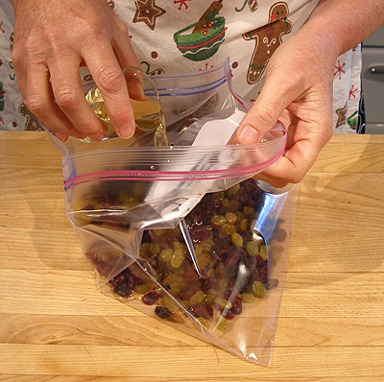
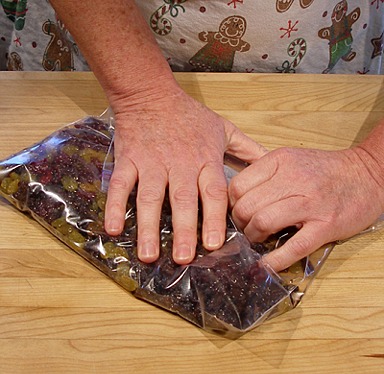
Heat the fruit (with the liquid) in the microwave for 1 1/2 minutes. Remove from microwave and set the sealed bag stand for one hour.
Then, drain the fruit, reserving the remaining liquid for the recipe. The liquid is used as flavoring. Use no more than 3 – 4 tablespoons for the recipe.
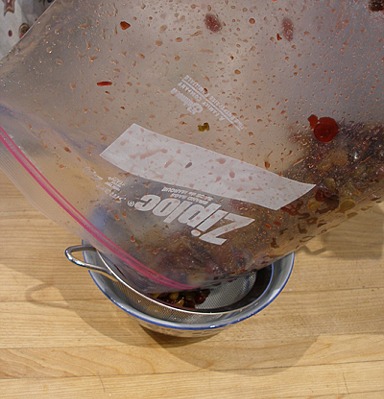
Prepare a stockpot:
1. Lightly grease a large stockpot with vegetable oil. Do not forget to grease the inside of the lid.
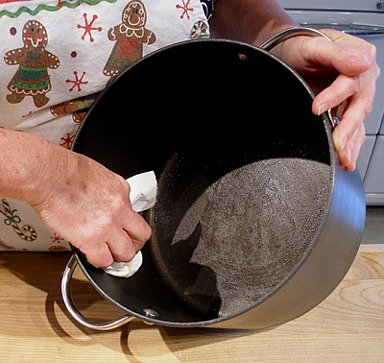
2. Set aside to use for when you finish mixing the panettone dough.
Mix the panettone dough:
1. In the bowl of the heavy-duty stand mixer, add the flour, sugar, salt.
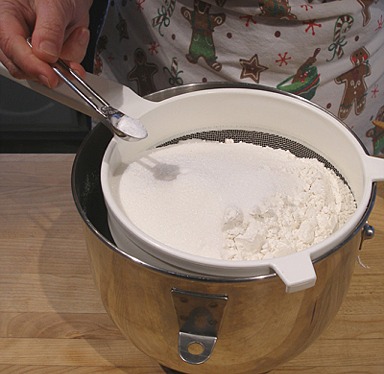
Then, the yeast, lemon and orange zests.
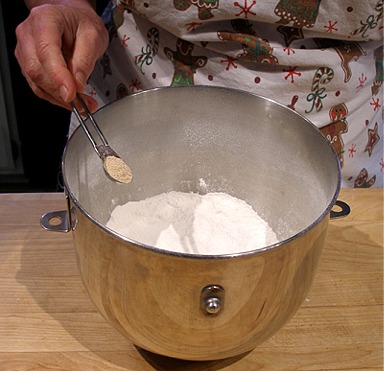
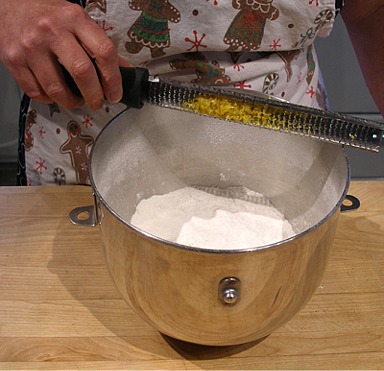
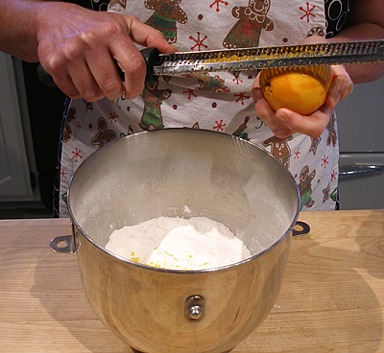
2. Clamp on the mixer bowl to the stand mixer. Fit the mixer with the paddle attachment and mix at low speed.
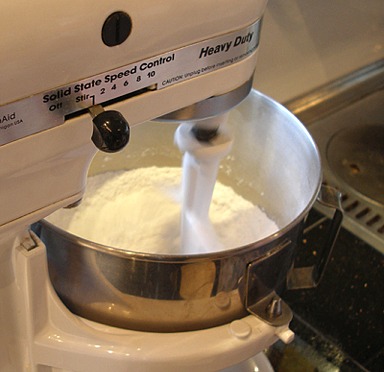
3. Add the eggs, water, honey, vanilla, and 3 – 4 tablespoons of the reserved fruit-soaking liquid.
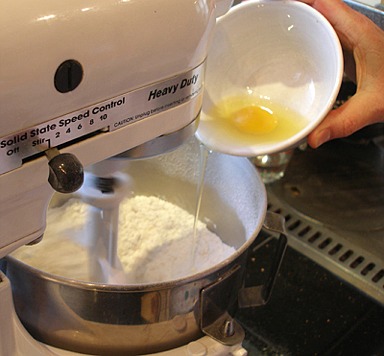
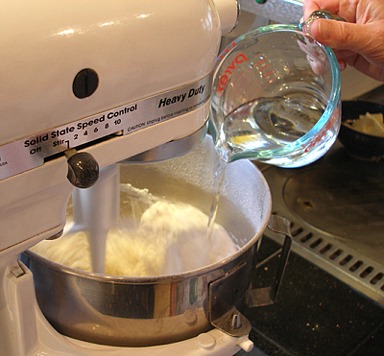
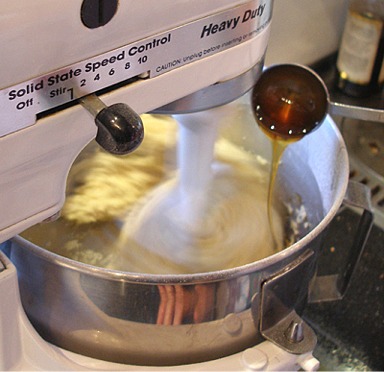
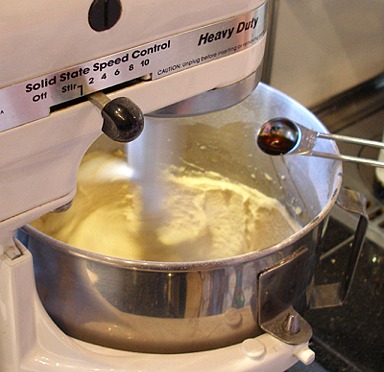
4. Set the mixer speed to medium-low speed and mix until a thick batter forms, taking about 1 minute.
Adjust the consistency of the dough with teaspoons of water or fruit-soaking liquid or pinches of flour.
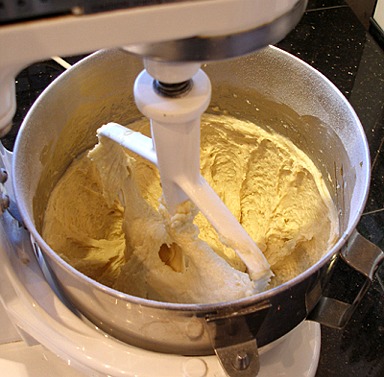
5. Switch to the dough hook attachment. At low speed, add the 10 tablespoons butter, 1 tablespoon at a time, mixing after each before adding the next.
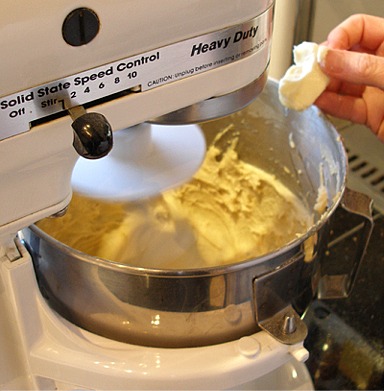
6. Increase the speed to medium, and continue kneading until the dough is smooth and elastic, about 8 – 10 minutes.
The dough should be sticky, but not wet; add sprinkles of flour if necessary to achieve the proper consistency. Mix after each small addition.
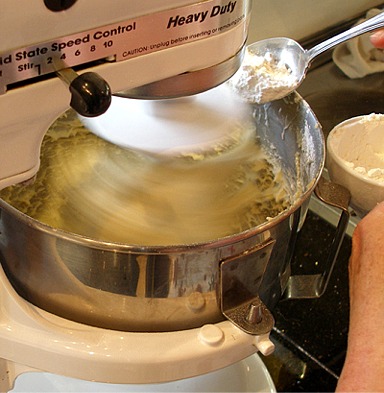
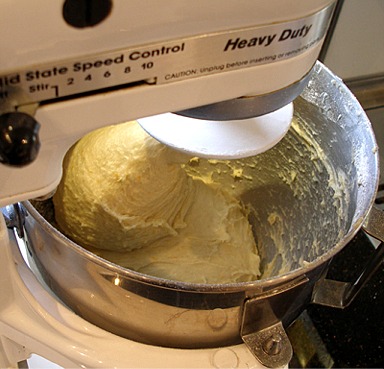
7. Add the soaked dried fruit, and knead at medium speed until evenly incorporated, about 2 minutes more.
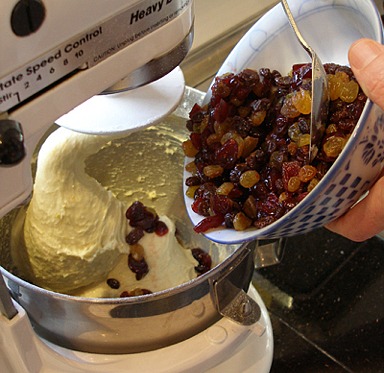
8. Transfer the dough to the prepared lightly oiled stockpot. Do not tear at the bread dough while doing so because you will damage the developed gluten strands, necessary for structure, and release valuable air bubbles.
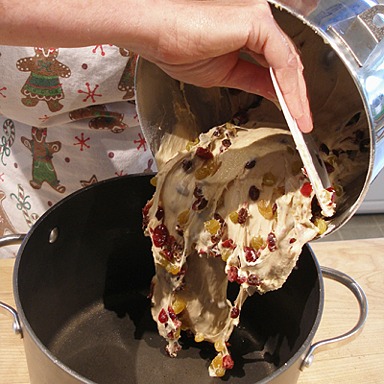
9. Turn the dough in it so it is evenly covered in oil.
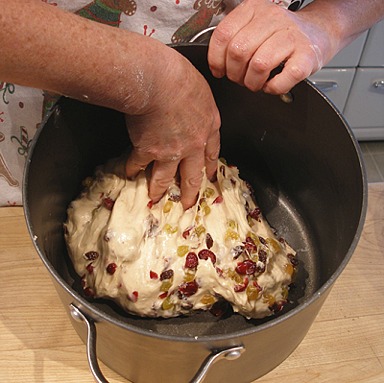
STEP II: LET THE PANETTONE DOUGH RISE. GENTLY DEFLATE AND SHAPE, LET RISE FOR A SECOND TIME.
1. Put the lid on the stockpot, and let the dough rise in a warm place overnight or for about 12 to 15 hours, or until the dough is nearly tripled in volume.
Here is where the bread's flavor is further developed as the bread ferments and further kneads itself while it rises.
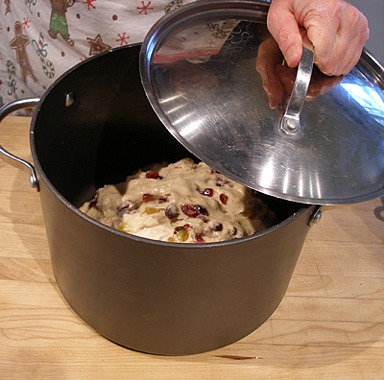
NOTE: My oven has a pilot light and it gets pretty hot in there, so I let mine rise on the top of the stove, where it is only slightly warm. I let mine rise overnight, for about 12 hours.
2. Meanwhile, prepare the panettone mold.
If using a paper pannetone mold: Pierce two long metal skewers all the way through the panettone paper mold, as close to the bottom as possible. Set aside.
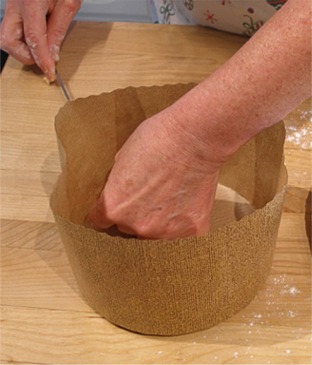
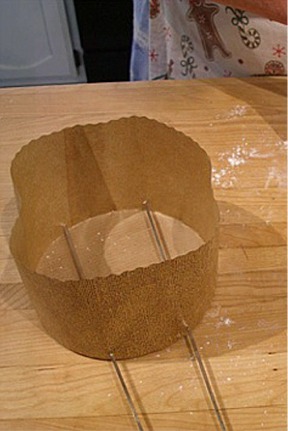
NOTE: When the panettone is baked, it needs to hang upside down to cool in Step III. The skewers will help hold the mold and bread in place.
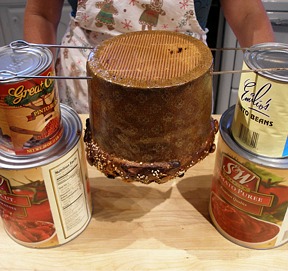
If using two coffee cans: Remove paper or plastic labels. Generously grease both coffee cans with shortening or vegetable oil spray. Line bottom and side of each with parchment (use a round for bottom and a rectangle for side).
3. When fully risen, dust the top of the dough with a little flour. Do not punch down the dough.
Gently turn it out onto a lightly floured work surface; this action will gently deflate the dough.
Sprinkle a little more flour over the top of the dough.
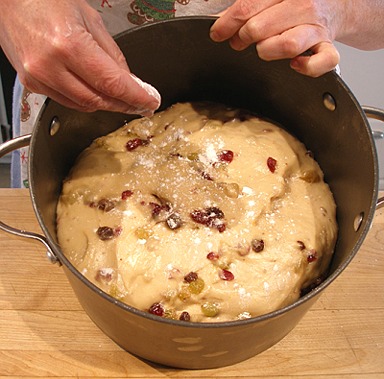
NOTE: If using two coffee cans to bake the loaves in, divide the dough evenly with a bench scraper or sharp knife. Cut straight down.
4. With floured hands, fold the outside edges into the center, pressing VERY gently so as not to fully deflate the dough.
All seams should meet in the center. Do not overly stretch or tear the dough. If you do, the bread will not rise as high and will be tough.
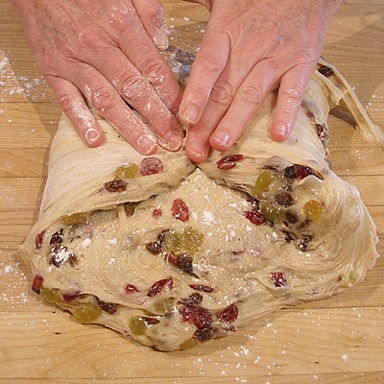
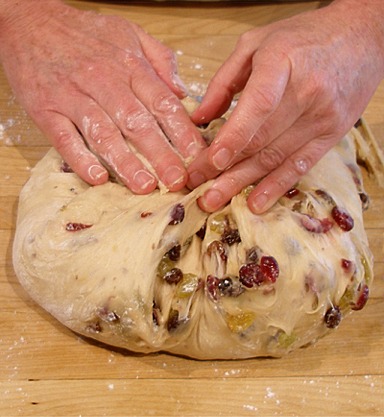
5. Flip the dough over, with seams pointing down, so the dough looks like a rough balloon shape.
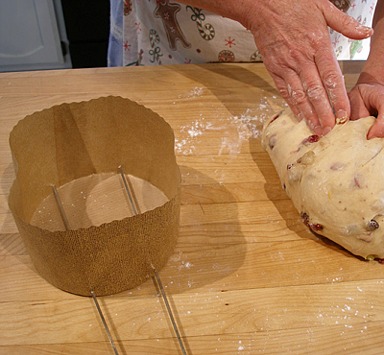
Gently fit it into the prepared paper panettone mold pierced with metal skewers.
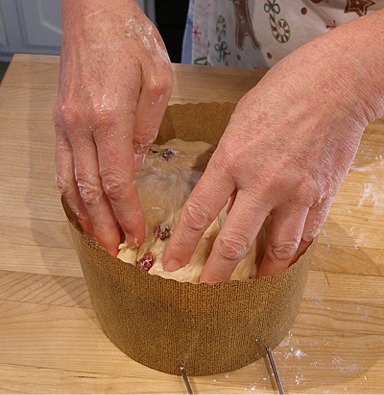
6. Cover the dough loosely with lightly oiled plastic wrap.
Let rise at room temperature until the dough is just above the top of the mold (more than doubled in size), about 3 to 5 hours.
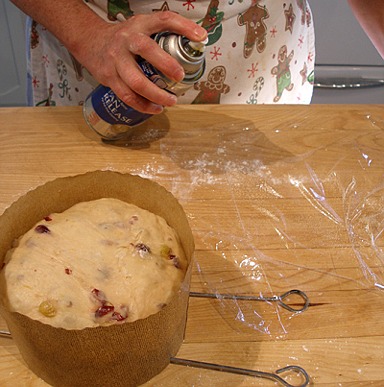
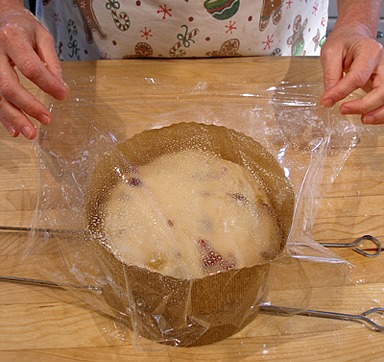
STEP III: BAKE THE PANETTONE AND LET COOL.
1. Thirty minutes before baking, place the rack in the lower third (closer to the bottom than the middle) of the oven.
If the dough is too high in the oven, the top will brown before the middle is cooked, resulting in a burned top crust.
2. Preheat the oven to 375 degrees F
3. Place the risen dough in the paper mold on a baking sheet. Brush the top with beaten egg wash.
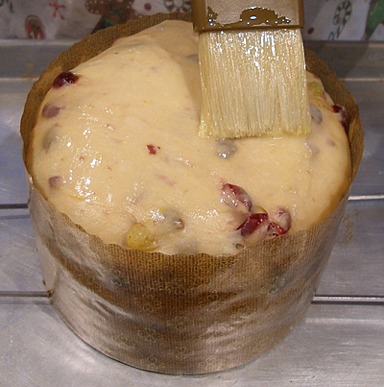
Sprinkle with Pearl sugar.
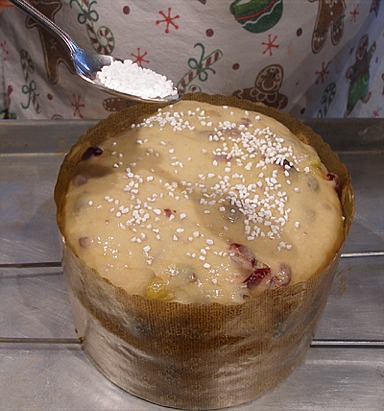
Use a lame or a serrated knife to score a starburst shape across the top of the dough. Cut each about 1/4 inch deep at a 30 degree angle, so
the bread will expand and open-up properly.
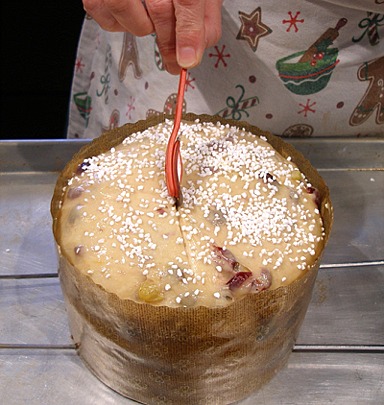
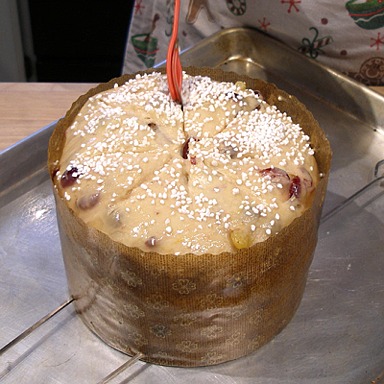
Optionally, decorate with blanched almonds.
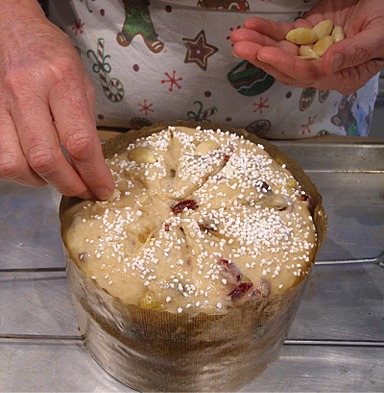
Place 1 tablespoon chilled butter in the center of the star burst pattern.
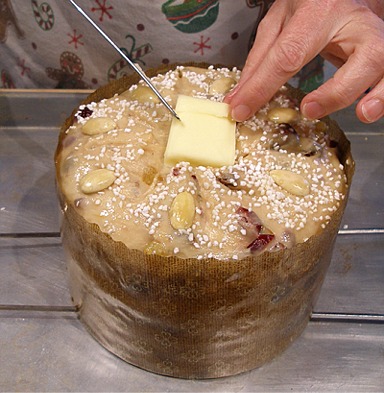
5. Bake one loaf for a total of 1 to 1-1/4 hours in the preheated oven:
Bake at 375 degrees F for about 30 minutes.
Reduce the oven heat to 350 degrees F. Bake another 30 to 45 minutes minutes, until a wooden skewer inserted in the center comes out slightly moist but not wet or doughy.
If it begins to darken too much during baking, place a loose tented piece of aluminum foil on top.
NOTE: Bake panettones in two coffee cans for about 35 to 40 minutes at 375 degrees F or until a wooden skewer inserted in the center comes out slightly moist but not wet or doughy.
The panettone will be very dark but not be burned.
6. When done, if using a paper panettone mold pierced with skewers, immediately hang the panettone upside down between two objects of equal height.
NOTE: If using two coffee cans, let sit on wire cake rack for about 15 minutes. Frmly thump bottoms of inverted cans to remove. Transfer loaves to a rack and discard parchment.
Cool completely.
7. Optionally, sprinkle with powdered sugar for presentation or gift giving.
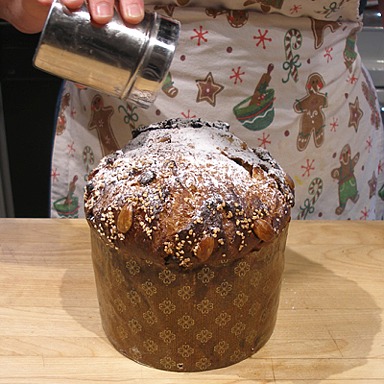
SERVE
Remove the paper and slice into wedges for serving.
STORAGE
Panettone should last for about 2 weeks at room temperature, tightly wrapped. The bread freezes nicely.




